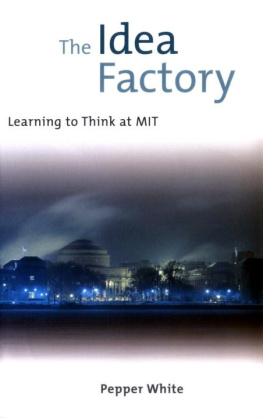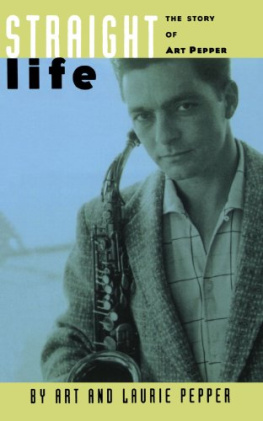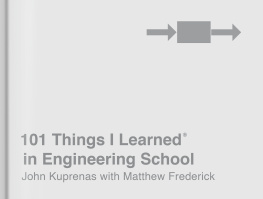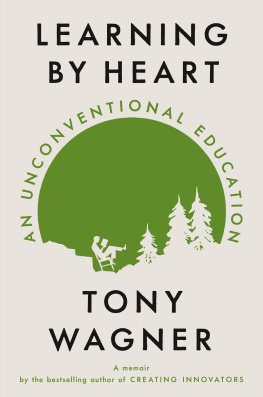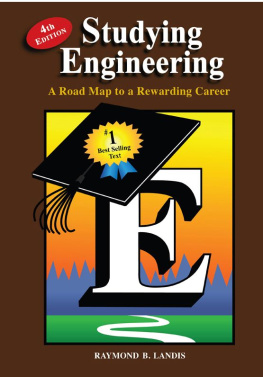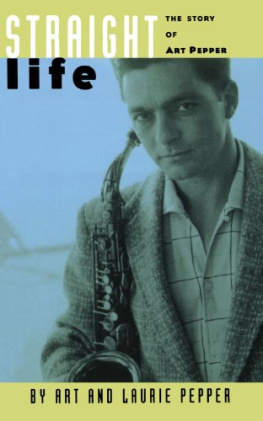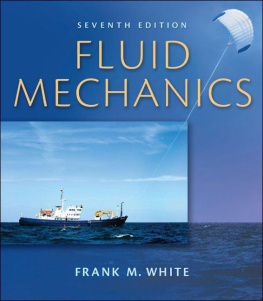T H E
IDEA FACTORY
T H E
IDEA
FACTORY
LEARNING TO THINK
AT MIT
PEPPER WHITE




This book is dedicated to my mother and to the memory of my father.
Acknowledgments
Many people helped and encouraged me along the way to the first publication of this book. Among them were John Mattill, Liz Muther, Linda Simon, Aklilu Gebrewold, Carl Brandt, Bill Newlin, Bill Ijams, and the anonymous editor at Putnam who, in a rejection letter, told me to find a literary agent if I ever wanted to publish this book.
Thanks also to the MIT professors and friends who reviewed sections of the original version; special thanks to Professor Elias P. Gyftopoulos for permission to use material from his course notes and textbook "Thermodynamics: Foundations and Applications" (Macmillan, 1991), and for his corrections.
Many thanks to Malaga Baldi, my literary agent. And thanks to the late Alexia Dorszynski, my first editor, who told me not to censor myself and who did not censor me.
Thanks to Larry Cohen, Editor-in-Chief at The MIT Press, who in the winter of 1984 was the first person to whom I submitted a primitive manuscript. His encouragement at that time helped me persist, and I appreciate the present opportunity to return the book to print.
Finally, warm thanks to my wife, Elizabeth Ross White, whose review comments greatly improved the new material in this edition.
C O N T E N T S
xiii
Chapter 287
Can we not bridge the chasm which thus makes for civil strife within the mind? The extremists on both sides say, no! The poet and the man of faith affirm that only through man's spirit, through intuitive understanding, can he touch true reality. Those who have harder heads will toss this attitude aside as hopeless mysticism, irrational and false. Most men cannot decide on either course, and attempt to live a double life. The Hyde who holds discourse with science is a different man from the Jekyll of art or politics or religion. This divided allegiance is accepted as inevitable by many.... But such duality can hardly offer a sound basis for any satisfying life philosophy. At best it is demoralizing, at worst, perilous....
-From Edward W. Sinnott, "Science and the Whole Man," centennial address, Sheffield Scientific School, Yale University, October 1947
Preface to the MIT
Press Edition
"The book wasn't harsh enough."-an MIT Ph.D. who is also a Harvard M.D. (1999)
"I read it and that's why I wanted to come to MIT."-an undergraduate in an MIT course that included this book as required reading (1996)
"That book keeps coming up at meetings."-an MIT professor (1993)
"If you want to see why I haven't given any money to MIT, read Pepper White's book."-a wealthy potential donor to MIT who went there for graduate school (1992)
"It's the saddest book I've ever read."-a sales clerk at the MIT Cooperative Society (1991)
I received my master's degree from the Massachusetts Institute of Technology (MIT) in 1984. The first edition of this book was published in 1991. The MIT Press edition appears in 2001.
Salman Rushdie said that books choose their authors. My father was a science writer, a Harvard-educated engineering major who after World War II worked for Vannevar Bush. My mother is a gifted pianist who has educated me about the spiritual dimension of music. At Johns Hopkins I had a liberal arts engineering undergraduate education, including art history, cinema, foreign languages, and time and opportunity to develop as a person.
A clerical error led to my being accepted to MIT, through the back door of the "Technology and Policy" program. A generous act led me to a paid research assistantship and a veritable genius as my thesis advisor. An unplanned absence placed me for two years in an undergraduate dormitory. And Professor Warren Rohsenow required me to take the core undergraduate mechanical engineering curriculum in addition to my graduate courses. An invisible hand led me through the depths and heights of the Institute.
Shortly after my father passed away in 1988, I found among his personal papers the Edward W. Sinnott quotation from a prior page, as well as other excerpts of the address. I took it home with me. When attempting a year later to discover what this book was to be about I dusted off the yellowing onion-skin-papered carbon copy and felt goose bumps. It was a gift from my father. The rational and the expressionistic. Dialectical materialism-the state philosophy of the former Soviet Union-and religion. Thesis and antithesis. The tares and the wheat.
Looking at the book ten years after its first edition, I see it as answering three questions, the first of which is, What is it really like to go to MIT?
Second, What does it mean to learn to think? The first professor I met told me that it didn't really matter what I learned there, but that MIT would teach me "how to think." What are the small steps that cumulatively form an engineer? How does an engineer learn to solve problems? How does he or she maintain relationships and friendships during the process?
Finally, What are the limits of mechanistic thinking? Does it lead to isolation, loneliness, burnout, and an unfulfilling life? Can it leave room for the religious, the inspirational, the spiritual?
This third question has been much discussed in the last halfcentury. Several years after the Sinnott address, C. P. Snow delivered a lecture entitled "The Two Cultures" at the University of Cambridge. In the 1950s, when MIT was embarking on an early effort to bridge the two cultures, Adlai Stevenson is reported to have said that MIT was trying to humanize the scientists, while Harvard was trying to Simonize the humanists. (For younger readers I hasten to explain that "Simonize" was a service that cleaned and polished cars.) As recently as October 21, 2000, the Boston Globe had a front page article entitled "Turning techs into humanists," with the subhead "Schools shaping the whole engineer."
I was at MIT between 1981 and 1984. I wrote a first draft of the book by scheduling weekly meetings with John Mattill, former editor of Technology Review, during the spring of 1984, while much of the experience was still fresh in my memory. In the summer of 1989 it went under contract with Dutton, and it was first published in the fall of 1991.
The events occurred nearly 20 years ago, but whenever I read an article in the newspaper about MIT, I say to myself "that's in my book." I encountered and wrote about binge drinking, the lack of sufficient dorm space for freshmen, the poor treatment of women, suicide. The Institute has tried to correct these problems. And it may have been successful in some of its efforts.
When I gave a talk to a class of MIT undergrads in the spring of 1996, many of them said that they didn't think the experience was as hard as I had described in the book. Which may mean that the Institute has changed somewhat because of the book.
But as one of this book's characters says, "MIT is a dragon I have to slay." Ten thousand of the smartest, hardest-working people in the world are placed together within the several hundred acres of the MIT campus, and they are driven by 1,000 even smarter professors. The touchy-feely soft stuff of making the Institute a kinder gentler place will of necessity always take a back seat to the real business of inventing, discovering, and becoming highly skilled.

